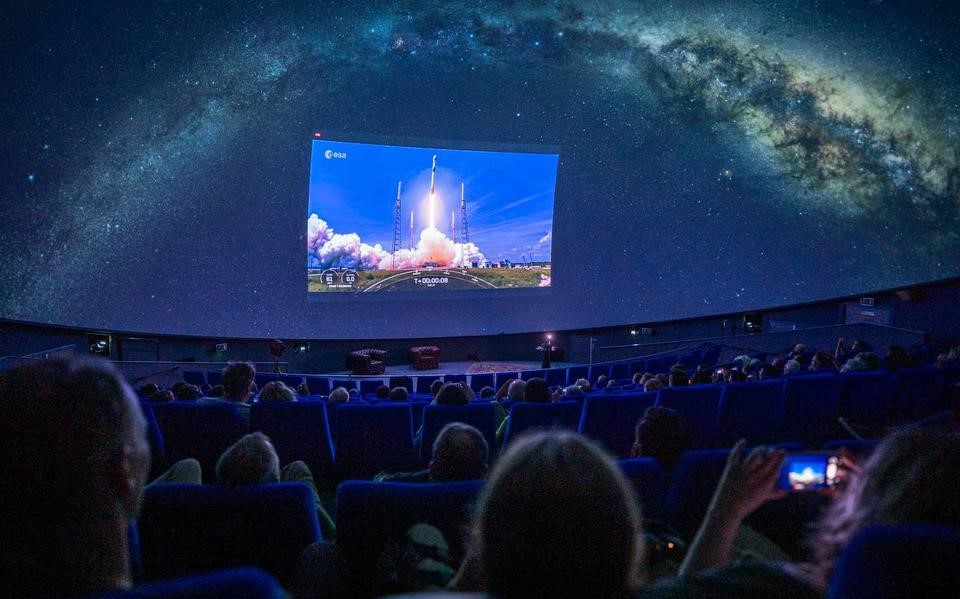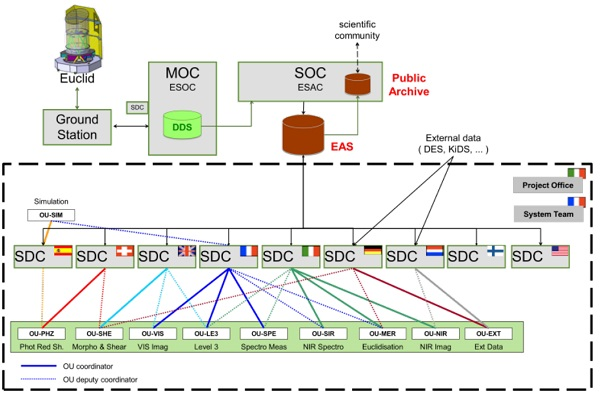Euclid has been launched!
The Euclid Satellite, a project on which some of us in the CIT have worked for more than 12 years, was launched at 17:12 (CEST) on the 1st July. We expect the first data to be processed by the Euclid Netherlands Science Data Centre, which is hosted by the CIT, in August.
Euclid: the mission
Euclid is an ESA mission to map the geometry of the Universe and better understand the mysterious dark matter and dark energy, which make up most of the energy budget of the cosmos. The mission will investigate the distance-redshift relationship and the evolution of cosmic structures by measuring shapes and redshifts of galaxies and clusters of galaxies out to redshifts ~2, or equivalently to a look-back time of 10 billion years. In this way, Euclid will cover the entire period over which dark energy played a significant role in accelerating the expansion of the Universe.
Euclid Netherlands Science Data Centre
The processing of Euclid data will take place at 9 national science data centres (see figure below). The Euclid Netherlands Science Data Centre has been jointly developed by the Kapteyn Institute and the CIT, with the participation of the Leiden Observatory. The Euclid Netherlands Science Data Centre makes use of existing facilities at the University of Groningen’s Center for Information Technology (CIT). This is significantly more cost effective than supporting dedicated systems. At the current time, it has the following resources:
- 2800 TByte of storage in the CIT Data Handling System for bulk file storage.
- 80 TByte of SSD storage and two ORACLE database servers in the CIT VMWare Database Infrastructure to store Euclid metadata.
- 7 application servers in the CIT Data Handling System to support the Euclid Data Processing System services.
- 640 dedicated cores in the CIT Hábrók High Performance Cluster for compute.
CIT Staff Involvement
Many CIT staff have made significant contributions to the development of the Euclid Netherlands Science Data Centre and are now also involved in the operations.
- The CIT HPC Data Handling team (particularly Robin Teeninga, Ger Strikwerda, Henk-Jan Zilverberg, Wim Nap and Hopko Meijering) for designing and maintaining the Data Handling System of which Euclid is the biggest user.
- The entire CIT HPC Hábrók Team for creating such an excellent new facility and ensuring that the demanding Euclid data processing jobs can run efficiently.
- The CIT Instructure team (particularly Remco de Groot and Niels van der Beek) for providing and upgrading the CIT VMWare Database Infrastructure. This is used to store and retrieve the complex Euclid metadata needed during processing.
- The CIT Euclid Archive System Development Team (Rees Williams, Andrey Tsyganov and Bob Dröge) have developed, together with colleagues in the Kapteyn Institute, a novel system which spreads data storage and processing across the 9 national science data centres. Andrey Tsyganov has additional responsibility for the key Oracle database systems, both in the CIT and in the European Space Astronomy Centre in Madrid. Bob Dröge leads the work package for the Euclid Netherlands Science Data Centre infrastructure.
The significant contributions of two former CIT staff, Alex Pothaar and Wietze Albers, should also be noted.



| Laatst gewijzigd: | 04 oktober 2024 12:17 |
Meer nieuws
-
24 maart 2025
RUG 28e in World’s Most International Universities 2025 ranglijst
De Rijksuniversiteit Groningen is door Times Higher Education gerangschikt op de 28e plek in de World’s Most International Universities 2025 ranglijst. Daarmee laat de RUG instellingen als MIT en Harvard achter zich. De 28e plek betekent een stijging...
-
05 maart 2025
Vrouwen in de wetenschap
De RUG viert Internationale Vrouwendag met een bijzondere fotoserie: Vrouwen in de wetenschap.
-
16 december 2024
Jouke de Vries: ‘De universiteit zal wendbaar moeten zijn’
Aan het einde van 2024 blikt collegevoorzitter Jouke de Vries terug op het afgelopen jaar. In de podcast gaat hij in op zijn persoonlijke hoogte- en dieptepunten en kijkt hij vooruit naar de toekomst van de universiteit in financieel moeilijke tijden...
